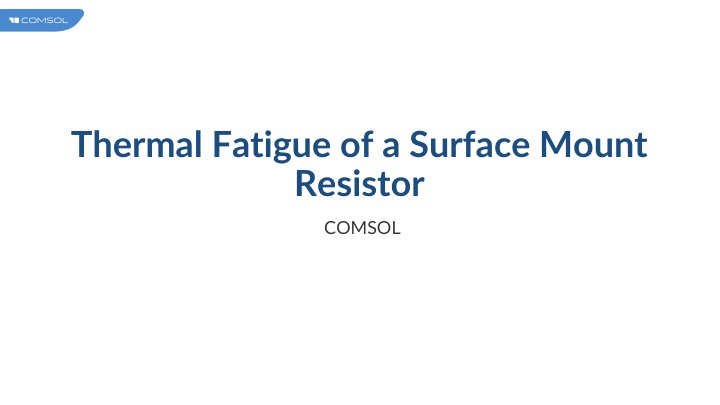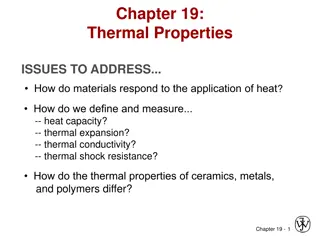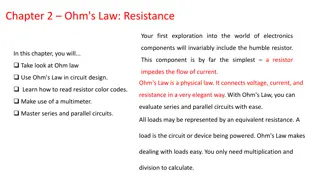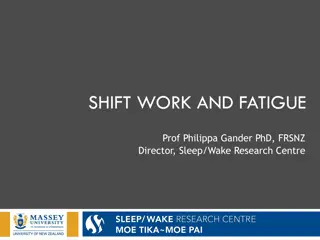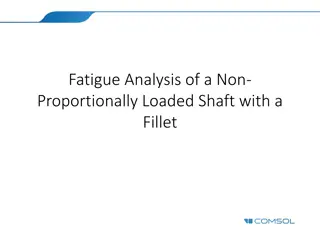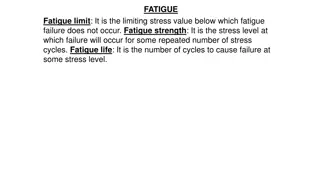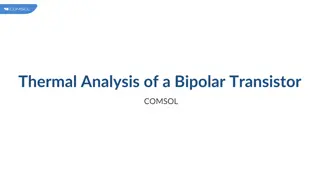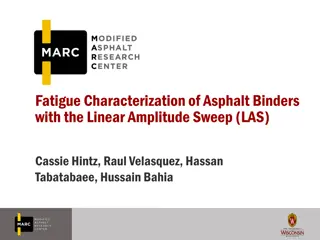Thermal Fatigue of a Surface Mount Resistor: A COMSOL Analysis
A COMSOL analysis is conducted on the thermal fatigue of a surface mount resistor subjected to thermal cycling. The study focuses on the solder joint, structural integrity, and life prediction using fatigue models. Various aspects of the resistor assembly, including material composition, dimensions, and solder joint shapes, are examined to understand the impact of thermal stresses and creep deformation on the component. Results indicate significant creep strains in the solder joint.
Download Presentation

Please find below an Image/Link to download the presentation.
The content on the website is provided AS IS for your information and personal use only. It may not be sold, licensed, or shared on other websites without obtaining consent from the author.If you encounter any issues during the download, it is possible that the publisher has removed the file from their server.
You are allowed to download the files provided on this website for personal or commercial use, subject to the condition that they are used lawfully. All files are the property of their respective owners.
The content on the website is provided AS IS for your information and personal use only. It may not be sold, licensed, or shared on other websites without obtaining consent from the author.
E N D
Presentation Transcript
Thermal Fatigue of a Surface Mount Resistor COMSOL
Introduction A surface mount resistor is subjected to thermal cycling The difference in the thermal expansion between the materials introduces thermal stresses in the structure The solder, connecting the resistor to the printed circuit board, is seen as the weakest link in the assembly Because the operating temperature is high when compared to the melting point of the solder, creep deformation occurs In order to assure the structural integrity of the component a fatigue analysis is performed where the life prediction from two different fatigue models is compared
Model Definition A resistor is fastened on a printed circuit board (PCB) with SnAgCu solder The solder is connected to the printed circuit board through two copper pads and to the resistor through a NiCr conductor In reality there are additional thin films around the resistor but they are disregarded in current analysis A sketch of the surface mount assembly is shown in the figure Schematic description of the surface mount resistor The resistor is made out of alumina and has dimensions 3.2 mm x 0.55 mm
Model Definition It is covered on both edges with a 0.025 mm layer of NiCr conductor The thin layer continues 0.325 mm along the lower and the upper side of the resistor The printed circuit board is large in comparison with the resistor and is here modeled 0.8 mm thick It has two copper pads on the top side that are 0.025 mm thick and 1.05 mm wide Schematic description of the surface mount resistor The thickness of the solder fillet between the copper pads and the NiCr conductor is 0.05 mm
Model Definition The remaining shape of the solder joint varies greatly between each examined solder joint and is here modeled with two representative roundings Schematic description of the surface mount resistor
Model Definition Solid Mechanics
Results Creep strains in the solder joint
Results Creep strain development in a critical point below the resistor
Results The position of this point can be debated It is however located in the area where the largest strains occurs and is therefore seen as the critical point In the figure the equivalent creep strain and the shear creep strain component are shown Creep strain development in a critical point below the resistor
Results Shear hysteresis evaluated in a critical point just below the resistor
Results It is clear from the two last figures that the first cycle is not representative for fatigue analysis, since its response differs significantly from the one experienced in the following cycles Even after six cycles, the stress-strain loop has not stabilized The temperature cycling can by extended with additional cycles to evaluate whether the state stabilizes further or not Under some conditions, it may happen that the hysteresis loop is moving in stress-strain space In this example additional cycles are not simulated since the difference in the creep strain and the dissipated energy between cycle five and six is small Assuming that the consecutive cycles follow the trend and deform less as, well as dissipate less energy, the fatigue analysis based on the results of the sixth cycle gives a conservative fatigue prediction The fatigue life based on the Coffin-Manson model is shown in the first graph, and the fatigue life based on the Morrow model is shown in the second graph
Results Fatigue life based on the creep strain
Results Fatigue life based on the dissipated energy
